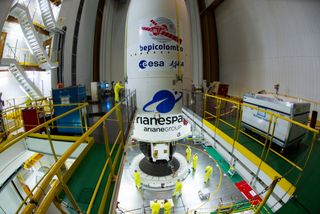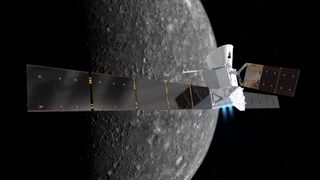BepiColombo, the First Mercury Mission in 14 Years, Launches Tonight — Watch Live!
Update for 11 p.m. EDT: The European-Japanese BepiColombo spacecraft have successfully launched toward Mercury. Read our full story here.
Original story: It's been more than 14 years since a spacecraft launched toward Mercury, so don't miss your chance to watch a rocket do just that.
BepiColombo, a European-Japanese project that will be just the third mission to study the solar system's innermost planet, launches tonight (Oct. 19) from Kourou, French Guiana, aboard an Ariane 5 ECA rocket. Liftoff is scheduled for 9:45 p.m. EDT (0145 GMT, Oct. 20), and you can watch the launch live at Space.com, courtesy of the European Space Agency (ESA).
The broadcast will begin at 9:15 p.m. EDT (0115 GMT, Oct. 20), with a half-hour of commentary leading up to launch. The BepiColombo payload will be deployed about 26 minutes into flight and will signal mission control about 15 minutes after that. The broadcast is scheduled to end at 10:30 p.m. EDT (0230 GMT, Oct. 20).

The launch was approved on Wednesday (Oct. 17) after a final review of the spacecraft and rocket, which rolled out in preparation for launch yesterday.
If the launch can't proceed at the scheduled time, liftoff will be delayed a full 24 hours. When ESA and the Japanese space agency, JAXA, announced their launch plans for this fall, they indicated that the launch window for this mission would last until Nov. 29.

Once BepiColombo blasts off, it will begin the seven-year journey to Mercury. The trip takes so long because the spacecraft has to fight the gravitational pull of the sun. In December of 2025, two paired spacecraft will separate and orbit Mercury independently.
Get the Space.com Newsletter
Breaking space news, the latest updates on rocket launches, skywatching events and more!
The mission, which Spaceflight Now has reported cost a total of almost $2 billion, will last for a year, with a possible one-year extension. During that time, the two spacecraft will investigate a range of questions about Mercury. Activities will include measuring the planet's interior structure, studying surface features and watching how the planet's magnetic field interacts with the flow of charged particles that constantly streams off the sun.
Email Meghan Bartels at mbartels@space.com or follow her @meghanbartels. Follow us @Spacedotcom and Facebook. Original article on Space.com.
Join our Space Forums to keep talking space on the latest missions, night sky and more! And if you have a news tip, correction or comment, let us know at: community@space.com.

Meghan is a senior writer at Space.com and has more than five years' experience as a science journalist based in New York City. She joined Space.com in July 2018, with previous writing published in outlets including Newsweek and Audubon. Meghan earned an MA in science journalism from New York University and a BA in classics from Georgetown University, and in her free time she enjoys reading and visiting museums. Follow her on Twitter at @meghanbartels.
